
A look at post-millennium dystopian novels by women
Before Sir Thomas More parted company with his head over a disagreement with his former friend, King Henry VIII, he wrote a fanciful social treatise about a fabled place where enlightened leaders enacted rational and tolerant laws to rule a happy and peaceful people. We still use the name More gave his treatise, Utopia.
By the mid 1800s, "utopia" was common enough in the English lexicon to allow John Stuart Mill to take Parliament to task for its policies toward Ireland, which he characterized as "dystopian"—"bad place" or "anti-utopian."
At the turn of the twentieth century, utopian ideas of socialism, communism, and nationalism were forced on nations
through violent revolution, and held in place by totalitarian regimes. In short, the utopian had turned
dystopian, and these political circumstances inspired
 writers—mostly men at first, and most famously
in Brave New World by Aldous Huxley and 1984 by George Orwell—to explore what happens when
good intentions pave the way to hell.
writers—mostly men at first, and most famously
in Brave New World by Aldous Huxley and 1984 by George Orwell—to explore what happens when
good intentions pave the way to hell.

Between the publication of Brave New World and 1984, however, Ayn Rand wrote a less well-known dystopian novella, Anthem (1937). Anthem takes place in the far-future, in a totalitarian state that has robbed humans of all vestiges of individuality, right down to the first person singular pronoun, rendering them incapable of solitary thought, action, or innovation. Clearly, the book was inspired by Soviet Russia, where her family suffered financial hardship after the Revolution and from which Rand fled as a young woman.

Anthem is a useful touchstone in women's dystopian literature for a number of reasons. It depicts/predicts
the rise of a totalitarian state of nightmarish proportions against which contends a protagonist with sensibilities
much like our own—the stuff of classic dystopian fiction. And, like most dystopians, Anthem is
relentlessly humorless.
But unlike most dystopians by men, Rand's novel offers its characters an "escape hatch" out of the dystopia. Rand's protagonist does not, like Winston Smith in 1984, end up with a bullet in his state-washed brains. Nor is he banished by the state, as is Bernard at the end of Brave New World. Rand's protagonist and his lady love escape on their own initiative to the wilderness, where they will seek to carve out a new life for themselves.
When feminists took up the dystopian genre in the 1970s and '80s to raise alarms about the misogynistic nature of power, many of them—unconsciously, I'm pretty sure—followed Rand's formula. Like Rand's Anthem, these books were focused on a grim totalitarianism, specifically a totalitarianism run by male hubris and stupidity. See, for example, Margaret Atwood's The Handmaid's Tale (1985), or Sheri S. Tepper's The Gate to Women's Country (1988). Also like Rand, many of these authors offered characters an escape hatch.
Through the 1990s, women's dystopians became more complex; misogyny was only one of many threats facing humankind at the dawn of the millennium. In P.D. James's The Children of Men (1992), a near-future world in which fertility rates have dropped to zero drives the state to initiate compulsory fertility tests and encourage the suicide of the elderly. In Octavia Butler's The Parable of the Sower (1993) the main threats come not from totalitarianism but from social chaos caused by climate changes and the collapse of economic structures. But in both James's and Butler's novels, the escape hatch is still open. If the endings are not happy, they are at least hopeful.


In more recent women's dystopians, however, the escape hatch seems to be closing as the number of social
evils in these worlds of the future multiply. For example, totalitarianism and strife between the sexes
is still part of the landscape in Sarah Hall's The Carhullan Army (published in the US under the
title of Daughters of the North)(2007), but these bogeymen share the stage with climate change,
crumbling urban infrastructure, and dwindling supplies of energy.
The Carhullan Army begins where many feminist dystopians end. The protagonist, known only as Sister, seems to have found her escape hatch early in the book, running away from a dreary city and even drearier husband to a women‘s commune known as Carhullan. But to what has she escaped?
Carhullan offers fresh air, wholesome food and surroundings for the women who live there, but it is no paradise. The work is hard. Food is sometimes rationed. Material for clothing is sometimes scarce. Men are forced to live at a distance from the commune in conditions of near-squalor. More unsettling is Sister's violent first encounter as an outsider seeking entry into Carhullan.
Jackie, a former combat soldier, is Carhullan's founder and leader. She is remote, reveals and gives little of herself. Sister learns about her mostly from the other women. Jackie spends mostly of her time training her elite defense squad with increasingly punishing exercises. As Sister is pulled closer into Jackie's inner circle, she defends Jackie's tactics:
It is about here where Hall's narrative breaks into two strands, the one that Sister tells on the page, and the one the reader must piece together from what Sister does not say. In the end, The Carhullan Army forces us to consider that hearts of darkness exist not only in a dystopia, but among those purporting to build their own Brave New Worlds outside it.

 Like Hall's novel, Ninni Holmquist's 2006 novel, The Unit, explores the psychological effects of a
dystopian society. As the book opens, it is Dorrit's fiftieth birthday. She puts her affairs in order,
packs a small bag, and waits at her ramshackle farmhouse for a dark SUV to take her to the state-run Unit.
There the cheerful attentive staff shows her to her new quarters:
Like Hall's novel, Ninni Holmquist's 2006 novel, The Unit, explores the psychological effects of a
dystopian society. As the book opens, it is Dorrit's fiftieth birthday. She puts her affairs in order,
packs a small bag, and waits at her ramshackle farmhouse for a dark SUV to take her to the state-run Unit.
There the cheerful attentive staff shows her to her new quarters:
The Unit is one of several installations in a near-future Sweden, where birth rates have plummeted and money and resources are limited. People like Dorrit, who have no children and are past the age of childbearing, go to the Unit, where they live comfortably, receive good food and medical care, and have artistic outlets. It could be worse, as Dorrit keeps telling herself. And it undoubtedly would be were the point not to keep Unit residents healthy so that they can be used in medical experiments or as organ donors.
Kept inside the climate-controlled Unit with its hothouse fake sunlight and breezes, the
Unit residents become emotionally fragile, and most are ready to make their "final
donation" voluntarily
within a few years of entering the facility.

Dorrit's stay in the Unit seems to follow the established pattern until surprising circumstances give her the will to escape. And a hatch does open. But can plants in a hothouse survive outside that artificial environment? Holmquist's novel is its beautifully written unsentimental and understated prose. The recurring images of a fossil, a pet dog, and the feel of winter's cold delicately reveal Dorrit's changing moods and underscore the exquisite cruelty of a place where utilitarian logic reigns instead of human hearts.

Margaret Atwood's The Year of the Flood (2009) and Kit Reed's Thinner Than Thou (2004) are
less relentlessly dark than Hall's or Holmquist's novels. In fact, a dark humor pervades these books, both
of which raise warnings about our culture's pursuit of youth and beauty, corporate greed, and the darker
aspects of popular religious movements.
The Year of the Flood is a parallel read with Atwood's earlier dystopian Oryx and Crake. Where Oryx followed genetics experiments gone horribly wrong in tightly secured corporate compounds of the future, Flood explores the pleeblands, the high-crime, mall-ridden landscapes outside the corporate world.
Toby is a Doubting Thomas in the God's Gardeners community, who manages to survive the "flood," the same bio-disaster that kills off the characters in Oryx and Crake. Circumstances lead her to the same beach where the hapless Jimmy the Snowman, who appears in both novels, is training a spray gun on three people who may threaten the genetically engineered Crakers, a race of humans bred in the corporate compound, and of whom he is the self-appointed guardian. The Flood takes the reader a few hours beyond that encounter.
Atwood's novel contains a dizzying array of dystopian bogeymen—bio-business, corporate arrogance, the pedophile sex trade, urban flight, shopping malls, and the beauty biz. Four hundred pages of this might have become unbearable in the hands of a lesser writer. But Atwood wisely alternates Toby's story with a first person "diary" of her friend Ren, also a former God's Gardener, who has become an exotic dancer and provides a kind of ditzy Lorelei Lee commentary on events:
Intercut between the two main narratives are saint's day sermons by Adam One, the Dumbledorian founder of God's Gardeners. The Gardeners have many saints—St. Dian Fossey, St. Euell Gibbons—and the sermons provide the novel with a chronological framework and rhythm, each sermon revealing what's happening in the wider world away from Toby and Ren. Included with the sermons are hymns with such sly titles as "My Body is My Earthly Ark" and "The Water Shrew That Rends Its Prey," most of which can be sung to familiar tunes from the Anglican hymnbook. (Musician Orville Stoeber was apparently so taken with the hymns, that he set them to his own music. You can listen to snippets at the book's Web site).
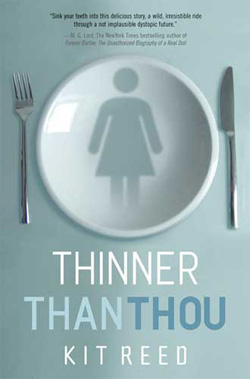

Reed also uses multiple narrative techniques in Thinner Than Thou, in which a mother, two siblings and a boyfriend, and a band of unattractive misfits separately and then together converge on a sanitarium where an anorexic girl has been sent by her father for making the family look bad. I mean, literally, she makes the rest of the family look bad by being unattractive, which, in Reed's dystopia, has become a social calamity. Says Annie, the anorexic teen:
Annie's sister Betz is a counterpart to Atwood's ditzy Ren. Driving into Aspen, Colorado, with her twin Danny and Annie's boyfriend Dave in their quest to find Annie, she observes that:
At the heart of Reed's novel is the Rev. Earl Sharpnack, a TV preacher who has ingeniously tapped into both ends of the fitness craze—the guilt-making of binge eating and sloth, and the redemptive powers of exercise, diet, and facelifts. On the surface, Rev. Earl is a perfectly sculpted creature who urges his considerable TV congregation to get healthy through prayer (and the Rev's highly addictive health and beauty nostrums). Behind the scenes, Rev. Earl runs a chain of seedy porn parlors in which hugely obese people gorge themselves while the crowd stuffs bills into their fat rolls.
In both Reed's and Atwood's books there is an escape hatch for some characters. Reed's Annie is sprung from her prison for anorexics, and some people survive Atwood's "flood." But in Reed's dystopian the racket Rev. Earl has created is just too good a moneymaking proposition to die. Atwood leaves Flood hanging with an impending meeting between humans and Crakers. Optimists might say, "Hey, lookit! The women have the guns this time! It's the dawn of a new, post-deluvian race!"
But, really, how many optimists read dystopians?

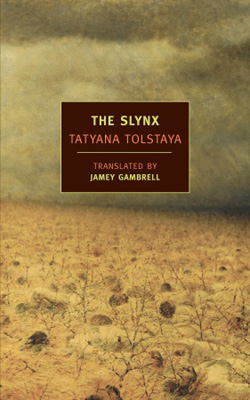 Finally, Ayn Rand's alarm against Soviet-style totalitarianism, in which language is altered to destroy
human individuality makes an interesting read beside Tatyana Tolstaya's The Slynx (2003), which
offers a post-Soviet dystopian fable. Tolstaya asks us to imagine a Russia three hundred years after an
event called the Blast (shorthand for today's anti-intellectualism which has blasted culture and literacy
into irrelevancy?) in which the past can scarcely speak coherently to the present.
Finally, Ayn Rand's alarm against Soviet-style totalitarianism, in which language is altered to destroy
human individuality makes an interesting read beside Tatyana Tolstaya's The Slynx (2003), which
offers a post-Soviet dystopian fable. Tolstaya asks us to imagine a Russia three hundred years after an
event called the Blast (shorthand for today's anti-intellectualism which has blasted culture and literacy
into irrelevancy?) in which the past can scarcely speak coherently to the present.
The protagonist Benedikt is a scribe in this new world, copying on bark snippets of great literature the head Murza (leader) passes off as his own. This is the only literature left, and much of it puzzles the Golubchiks (villagers). Here, a fellow scribe asks Benedikt what a "steed" is:
How many times he'd written that word himself, and had never thought about it. "It must be a mouse."
"What makes you think that?"'
"Because 'Don't I take care of you, don't I fill your trough with oats? That's it, a mouse."
"Well, then, what about 'The steed races, the earth trembles'?"
"It must be a big mouse. Once they start running around, you can't get to sleep."
Entertainment is drunken and violent. Golubchiks—live in shacks, eating mice, "worrums," and food and beer made from a bog plant called "rusht." Most other plants and animals are toxic. Nearly everyone is afflicted with genetic mutations, euphemistically known as Consequences. The Golubchiks are extremely superstitious, especially of the mythological Slynx, an invisible catlike predator who is said to jump the unwary, severing their arteries so that their common sense runs out and they become something like zombies.
The few survivors of the Blast were rendered more or less immortal, and these "Oldeners" remember culture and literature, though the world has changed so much that the Golubchiks scarcely understand what the Oldeners are talking about. In one episode, the Golubchik Benedikt humors Oldener Nikita by carving a wooden statue in honor of the Russian author Pushkin. Benedikt has no idea what "a pushkin" is, though he feels proud of his handiwork. But the other Golubchiks simply use the pushkin as an anchor for their clotheslines.
Ironically, books are the only escape hatch out of Tolstaya's landscape. When Benedikt marries Olenka, daughter of one of the Murzas, he discovers that the Murzas have been hoarding books as treasures. Benedikt becomes consumed with reading, though he can scarcely understand what he is reading. When he has read through his father-in-law's library, he turns into something very like the mythic slynx, a predator with a hooked weapon, breaking into houses where books might be hidden and killing their owners.
Many readers will find The Slynx hard going because of its loose plot structure, elements of fantasy and the grotesque, and references to Russian literature and culture. Best advice: Don't try too hard to make sense out of The Slynx; it's best seen as a kind of Terry Gilliam movie a la "Brazil."
The Slynx is probably the funniest of the books in this review. Atwood's Year of the Flood as well as Oryx and Crake offer a certain arch wit. And Reed's satiric humor owes something to Fay Weldon's revenge story, Life and Loves of a She-Devil. Humor is a relatively new element in women's dystopians, and but it certainly does not presage a more optimistic kind of dystopian. Certainly one cannot imagine Rand poking fun at the totalitarian state in Anthem; she believed that writing about a worst-case future might help humankind avoid it.
That women, who used to write escape hatches into their dystopians with dead seriousness are now closing the hatches and laughing is not, I think, a good sign. As the number of social evils on the horizon multiply, as the dystopian landscapes of a worst-case future become more complex, solutions seem thin on the ground.
When the escape hatch clangs shut, what resources do we have left to us but to see the absurdity of our
situation? Perhaps this is the way the world ends, not with a bang, but a laugh of derision.
 Jean Hughes Raber teaches college English and journalism in Michigan. She has a master's degree with
a concentration in medieval literature from Central Michigan University. The first book she ever read
by herself was "The Cat in the Hat." In 50 years of enthusiastic reading, she has never found a more
profound parable of totalitarian authority (Fish) vs. joyful anarchy (Cat). Her heroes include Harpo Marx,
Mother Jones, Dorothy Day, Studs Terkel, and, of course, Dr. Seuss. She lives with her husband, son, and
three joyfully anarchistic cats, all of whom just stepped in on the mat one day and never left.
Jean Hughes Raber teaches college English and journalism in Michigan. She has a master's degree with
a concentration in medieval literature from Central Michigan University. The first book she ever read
by herself was "The Cat in the Hat." In 50 years of enthusiastic reading, she has never found a more
profound parable of totalitarian authority (Fish) vs. joyful anarchy (Cat). Her heroes include Harpo Marx,
Mother Jones, Dorothy Day, Studs Terkel, and, of course, Dr. Seuss. She lives with her husband, son, and
three joyfully anarchistic cats, all of whom just stepped in on the mat one day and never left.
